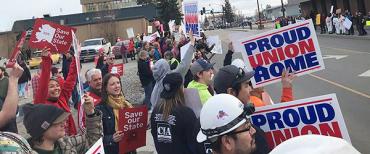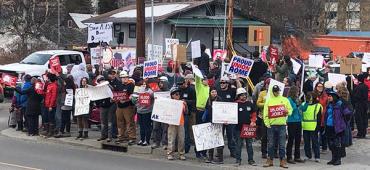Public employees in Alaska are bracing themselves for a wave of pink slips, and the University of Alaska is beginning to plan for at least a $5 million cut in funding as the state moves through the final stages of a drawn-out budget battle. Weeks after the state legislative session was scheduled to end, lawmakers finally passed a budget bill on June 10. It includes substantial cuts to essential public services like education, healthcare and transportation but fewer cuts than Gov. Mike Dunleavy’s original proposal. The governor is expected to reject at least part of it with line-item vetoes.
Dunleavy’s original budget would do unparalleled damage to public services across the state, cutting 25 percent or $1.6 billion from state spending. It would eliminate nearly one-fifth of the budget of the state Department of Education and Early Childhood Development, taking $315 million from K-12 education, $249 million from Medicaid spending and $134 million from the University of Alaska.That’s 41 percent of the university’s budget, an amount that could force layoffs for 1,300 faculty and staff members.
Dunleavy’s budget would also lop $95 million from the Alaska Marine Highway System—an amount so devastating that the system, a network of ferries that are necessary for getting food and other supplies in and out of the state’s remote island communities, would have to shut down after September.
A unique budget twist
The cuts are partly the result of an unusual measure called the permanent fund dividend, or PFD, an annual payment each Alaskan receives from a state-owned corporation that is fueled by the state’s rich oil and gas reserves. Originally a perk from the days when oil was a huge moneymaker in the state, dividend payments range from about $1,000 to $3,000 per person. But budget constraints have made it impossible to pay for both the full dividend and the full budget every year.
Controversy over the PFD, established in 1976, has been heating up for several years. Dunleavy made it a cornerstone of his campaign, promising a full PFD of $3,000; he says he will veto any legislation that misses that mark. At that rate, the PFD would cost the state $1.94 billion.
No PFD was included in the budget passed on to the governor June 10; instead, a separate bill was created to determine the final dividend amount.
Minimizing the damage
Meanwhile, state legislators have voted to control some of the more drastic cuts Dunleavy has proposed: Instead of the governor’s $1.6 billion in cuts, they recommend $190 million. They reduced the University of Alaska cut from $134 million to $5 million and decreased the Marine Highway System cut from $95 million to roughly $45 million. Their budget would cut Medicaid by $78 million, rather than the governor’s proposed $249 million. One in 4 Alaskans depend on this program for healthcare.
AFT members and staff have joined other advocates to fight the cuts, fanning out across the state and jamming phone lines to get this message to state legislators still working on a budget bill: “Save our state.” A petition against the governor’s proposal notes that such deep cuts most severely impact Alaska’s most vulnerable people—children, the elderly, the sick, and residents of rural and coastal communities. “This budget also harms local governments, further threatening a community’s ability to keep their citizens safe,” the petition reads. “This budget doesn’t put the people of Alaska first.”
Healthcare would be especially hard-hit, says Donna Phillips, president of the Alaska Nurses Association, who points out that the governor’s cuts endanger critical healthcare access for 210,000 of the most vulnerable Alaskans. “As a nurse, I know firsthand that when basic healthcare needs are met through programs like Medicaid and public health nursing, our entire state benefits,” she says. “Access to healthcare strengthens our families, our economy and our communities. Instead of cutting care from everyday Alaskans, we need to preserve it.”
Job loss is another deep concern, says Sharon Baker, president of TOTEM Association of Educational Support Personnel. “People are scared,” she says. “There are going to be thousands and thousands of people who will lose their jobs” with what she calls a “cut-and-gut” budget. She’s also anticipating the impact of a reduced workforce on students: With fewer teachers, class sizes will swell. She expects a decrease in new STEM (science, technology, engineering and math) programs that were recently established, and fewer career and technical education programs.
The University of Alaska has already cut about 1,200 faculty and staff positions, and eliminated 50 academic programs. With more cuts—especially at the level of the governor’s proposal—the university president has warned that numerous campuses would have to close.
“The cuts proposed will decimate the public services that Alaskans rely on for everyday life,” says Cecily Manning, president of the Alaska Public Employees Association, which has been at the forefront of the fight. “The impact on Alaskan communities, families and the economy is too much, especially when there are other solutions.”
A nationwide problem
While the permanent fund dividend is a uniquely Alaskan wrinkle, the budget crisis itself is not unique to the 49th state, and wherever it arises it threatens public services and public education. Twenty-one states spent less on K-12 education in 2016 than they did prior to the recession. Schools in these states have been shortchanged by $19 billion. In 35 states, between 2008 and 2016, the ratio of students to teachers grew; and in 38 states, the average teacher salary in 2018 was lower than it was in 2009. Forty-one states have shortchanged higher education by a total of $15 billion.
The AFT is all in for the fight to claw back some of this funding from policymakers who have favored tax cuts for the rich over revenue that could serve the public. By electing pro-public education, pro-public services candidates and advocating for working people at the state level, we’ve had big wins in places like Illinois, Louisiana, New Mexico and Texas, where education funding has begun to rise, lifting student services and teacher salaries significantly. Activism continues to move the needle in countless other states, with rallies, letter-writing campaigns, petitions and work sessions that really crunch the numbers and show unequivocally the many ways we can improve public services in our nation.
[Virginia Myers]


